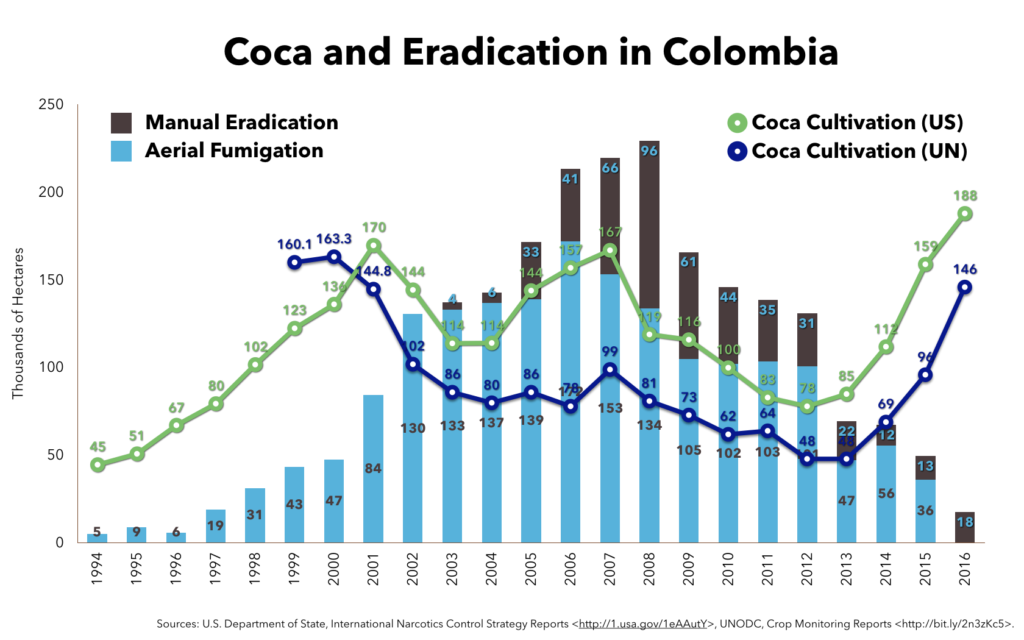On September 12, the U.S. Senate Caucus on International Narcotics Control held a hearing on Colombia’s counternarcotics efforts. Here’s a few notes on some of the most important trends worth keeping in mind when it comes to Colombia’s drug policy.
1.) Colombia has seen a sharp increase in cultivation of coca, the plant used to make cocaine.
The U.S. government estimated that, at the end of 2016, 188,000 hectares (465,000 acres) of Colombian territory were planted with coca. That’s a 133 percent increase from what the USG measured in 2013, and the highest U.S. estimate ever. The USG estimate of 710 tons of cocaine produced in 2016 is 202 percent greater than in 2013.
Using a different methodology, the UN Office on Drugs and Crime estimated that, at the end of 2016, 146,000 hectares (361,000 acres) of Colombian territory were planted with coca. That’s a 204 percent increase from what UNODC measured in 2013, and the agency’s third-highest estimate ever. The UNODC estimate of 866 tons of cocaine produced in 2016 is 34 percent greater than in 2015.

2.) While U.S. deaths from cocaine use increased in 2015, nearly all of the increase involved cases that also involved opioid abuse.
“Deaths involving cocaine without opioids have increased at a much slower pace than cocaine deaths that also involve opioids,” notes a July DEA report.
3.) Colombia is not a major source of opiates or opioids.
Assistant Secretary of State for International Narcotics Control and Law Enforcement Affairs William Brownfield said in March: “My estimate is that between 90 and 94 percent of all heroin consumed in the United States comes from Mexico. My estimate is that a very tiny percentage now, perhaps as little as 2 percent to 4 percent, comes from Colombia. And the remainder, which might be somewhere in the 4 to 6 percent category, comes from Asia, the majority of that coming from Afghanistan.”
4.) The end of aerial herbicide spraying is not the sole or main cause of the increase in coca growing.
5.) The peace accord with the FARC guerrillas is not the sole or main cause of the increase in coca growing.
In a March analysis drawing on numerous sources, WOLA identified seven reasons for Colombia’s coca cultivation increase. A singular focus on aerial eradication misses the picture. These reasons included:
6.) Today, focusing too much on the ex-FARC is an outmoded approach that won’t fix the problem.
In early 2017, the FARC concentrated 7,000 fighters and over 2,000 militia members into 26 small zones around the country and handed 8,112 guns in to the United Nations. As the guerrillas vacated their areas of influence, many areas experienced momentary disruptions to the coca trade, with buyers failing to appear and prices plummeting. The gap in the cocaine trade left by the FARC is being filled quickly, though, by smaller groups. They include organized crime structures like the “Urabeños” or “Gulf Clan” and many smaller entities; the smaller ELN and EPL guerrilla groups; and several hundred FARC “dissidents” who either rejected demobilization or deserted later.
As the ex-FARC leadership seeks to convert the group into a political party, Colombia will have to be vigilant to ensure that former guerrillas don’t engage in drug trafficking. However, any effort to reduce cocaine supplies would do well to focus more intently on these new groups, who are increasing their market share, instead of former FARC.
7.) The Colombian government has a plan. It’s not a perfect plan, but still deserves more support than the United States is giving it.
The Colombian government has declared a goal of eradicating 100,000 hectares of coca this year: 50,000 through forced manual eradication, and 50,000 through “crop substitution” accords reached with coca farming households—a measure foreseen in the November 2016 FARC peace accords. As of early September, Colombia’s ambassador to the United States said that 29,000 hectares had been forcibly eradicated and 15,000 had been “substituted or are in the process of being so.”
This is not an ideal plan. Bringing in forced eradicators is not the same as governing territory to ensure that replanting doesn’t happen. Giving farm families two years’ of support, valued at about US$12,000, will not be sustainable if the regions they live in remain empty of government presence, with no land titles, farm-to-market roads, security, or other public goods. (The peace accords call for such services to be delivered, but implementation is moving very slowly.)
Still, the plan holds some promise and is raising expectations in coca-growing areas. With strategic adjustments along the way, the U.S. government should treat this as an opportunity to achieve longer-lasting reductions in coca cultivation, instead of the quick but easily reversible gains won by herbicide fumigation.
WOLA applauds the Senate Appropriation’s Committee’s decision to maintain 2018 USAID Economic Support Funds for Colombia at 2017 levels (US$187.3 million). These funds are essential for implementing the coca-reduction strategy foreseen in the peace accord.
The U.S. government should also review an ongoing ban on supporting crop-substitution programs in areas where ex-FARC members are participating. Ex-guerrillas know the territory and population, and have close relationships with coca-grower organizations. If the Colombian state is in control and ex-guerrillas are encouraging coca growers to participate in good faith, then a local crop substitution agreement deserves U.S. support despite the former FARC’s status on the U.S. list of foreign terrorist organizations.
8.) We must strongly encourage Colombia to do more than just eradication and “crop substitution” in areas where there’s effectively no government.
Vast areas of rural Colombia have almost no government presence. That is a main reason it’s possible to grow coca, and a main reason why illegal groups are able to exercise authority. The 2016 peace agreement offers a historic opportunity to bring government into these zones. Violence levels are way down, and populations in many areas are clamoring for more attention from the government. U.S. encouragement, advice, and technical support can help Colombia avoid blowing this opportunity.